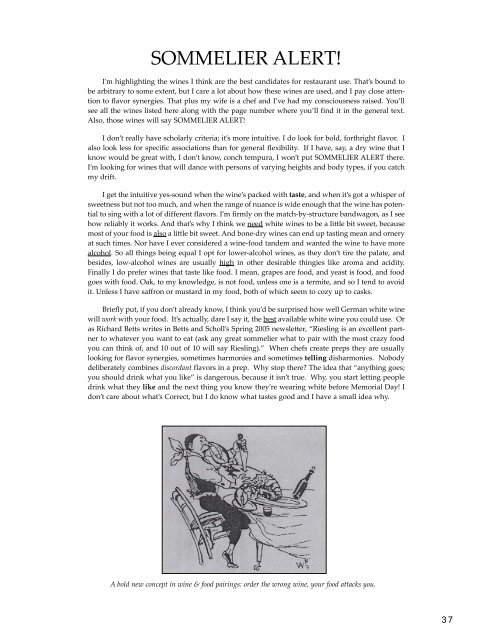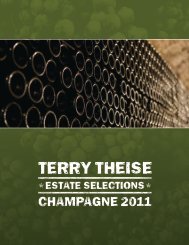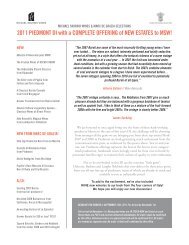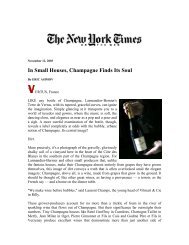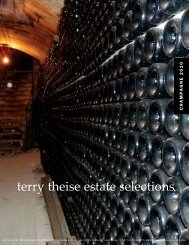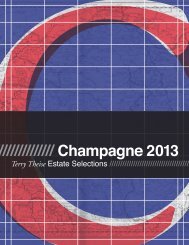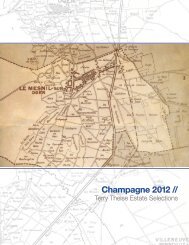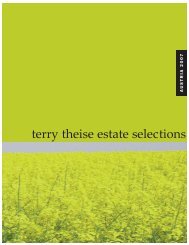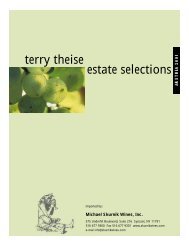German Catalog 2006 USE THIS ONE.qxp - Michael Skurnik Wines
German Catalog 2006 USE THIS ONE.qxp - Michael Skurnik Wines
German Catalog 2006 USE THIS ONE.qxp - Michael Skurnik Wines
You also want an ePaper? Increase the reach of your titles
YUMPU automatically turns print PDFs into web optimized ePapers that Google loves.
SOMMELIER ALERT!<br />
I’m highlighting the wines I think are the best candidates for restaurant use. That’s bound to<br />
be arbitrary to some extent, but I care a lot about how these wines are used, and I pay close attention<br />
to flavor synergies. That plus my wife is a chef and I’ve had my consciousness raised. You’ll<br />
see all the wines listed here along with the page number where you’ll find it in the general text.<br />
Also, those wines will say SOMMELIER ALERT!<br />
I don’t really have scholarly criteria; it’s more intuitive. I do look for bold, forthright flavor. I<br />
also look less for specific associations than for general flexibility. If I have, say, a dry wine that I<br />
know would be great with, I don’t know, conch tempura, I won’t put SOMMELIER ALERT there.<br />
I’m looking for wines that will dance with persons of varying heights and body types, if you catch<br />
my drift.<br />
I get the intuitive yes-sound when the wine’s packed with taste, and when it’s got a whisper of<br />
sweetness but not too much, and when the range of nuance is wide enough that the wine has potential<br />
to sing with a lot of different flavors. I’m firmly on the match-by-structure bandwagon, as I see<br />
how reliably it works. And that’s why I think we need white wines to be a little bit sweet, because<br />
most of your food is also a little bit sweet. And bone-dry wines can end up tasting mean and ornery<br />
at such times. Nor have I ever considered a wine-food tandem and wanted the wine to have more<br />
alcohol. So all things being equal I opt for lower-alcohol wines, as they don’t tire the palate, and<br />
besides, low-alcohol wines are usually high in other desirable thingies like aroma and acidity.<br />
Finally I do prefer wines that taste like food. I mean, grapes are food, and yeast is food, and food<br />
goes with food. Oak, to my knowledge, is not food, unless one is a termite, and so I tend to avoid<br />
it. Unless I have saffron or mustard in my food, both of which seem to cozy up to casks.<br />
Briefly put, if you don’t already know, I think you’d be surprised how well <strong>German</strong> white wine<br />
will work with your food. It’s actually, dare I say it, the best available white wine you could use. Or<br />
as Richard Betts writes in Betts and Scholl’s Spring 2005 newsletter, “Riesling is an excellent partner<br />
to whatever you want to eat (ask any great sommelier what to pair with the most crazy food<br />
you can think of, and 10 out of 10 will say Riesling).” When chefs create preps they are usually<br />
looking for flavor synergies, sometimes harmonies and sometimes telling disharmonies. Nobody<br />
deliberately combines discordant flavors in a prep. Why stop there? The idea that “anything goes;<br />
you should drink what you like” is dangerous, because it isn’t true. Why, you start letting people<br />
drink what they like and the next thing you know they’re wearing white before Memorial Day! I<br />
don’t care about what’s Correct, but I do know what tastes good and I have a small idea why.<br />
A bold new concept in wine & food pairings: order the wrong wine, your food attacks you.<br />
37


